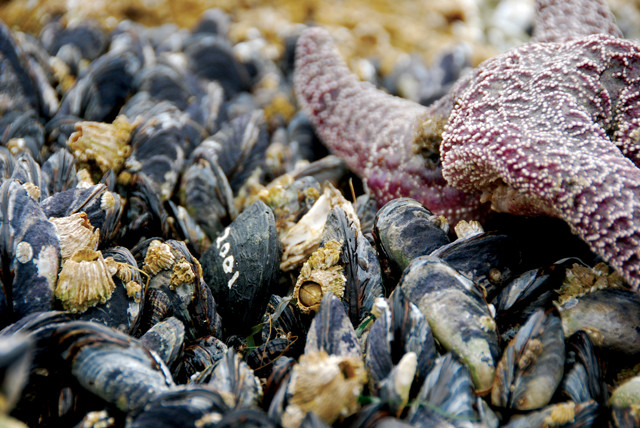
by Bethany Augliere Thursday, January 19, 2017

Researchers deployed fake mussels equipped with internal thermometers to record temperatures in living mussel beds. Credit: Brian Helmuth.
Among the crashing waves of rocky shorelines, tiny robotic mussels are providing scientists with insight into climate change impacts on marine life. The battery-powered “biomimics” hide among real mussels, with internal thermometers to estimate temperatures of their nearby living neighbors. Mussels’ body temperatures are changing with solar radiation, cloud cover and wind speed, says Brian Helmuth, a marine ecologist from Northeastern University in Boston. Because of this, the mussels’ body temperatures are generally much higher than the temperature of the surrounding air during exposure at low tide.
Over more than 18 years, Helmuth and a team of researchers have deployed these fake shellfish into mussel beds at more than 70 sites in 10 countries, where they measure temperature every 10 to 30 minutes. Recently, the database of temperatures was published in the journal Scientific Data, and is available to the public in its entirety for the first time.
To build the sensors, Helmuth and his colleagues planted commercial data loggers in either replica epoxy shells or real shells filled with silicone, designed in color, size and shape to match the thermal characteristics of living mussels. “Basically, we pop a mussel out of a mussel bed and then replace it with one these loggers,” he says. On average, the biomimics last about four years before they quit working or become dislodged from the beds by wave action.
So far, the team has found five hot spots along the coasts of California, Oregon and Washington where mussel body temperatures can reach lethal limits. The mussels in these hot spots experienced daily temperature fluctuations of up to 20 degrees Celsius. Such extreme changes are riskier for the mollusks than constant high temperatures because it’s difficult for the animals to adjust in just a few hours, which can cause them to shut down metabolically, Helmuth says. In places with these extreme changes, like Central California, he says, “we have observed fairly large die-off events.”
© 2008-2021. All rights reserved. Any copying, redistribution or retransmission of any of the contents of this service without the expressed written permission of the American Geosciences Institute is expressly prohibited. Click here for all copyright requests.